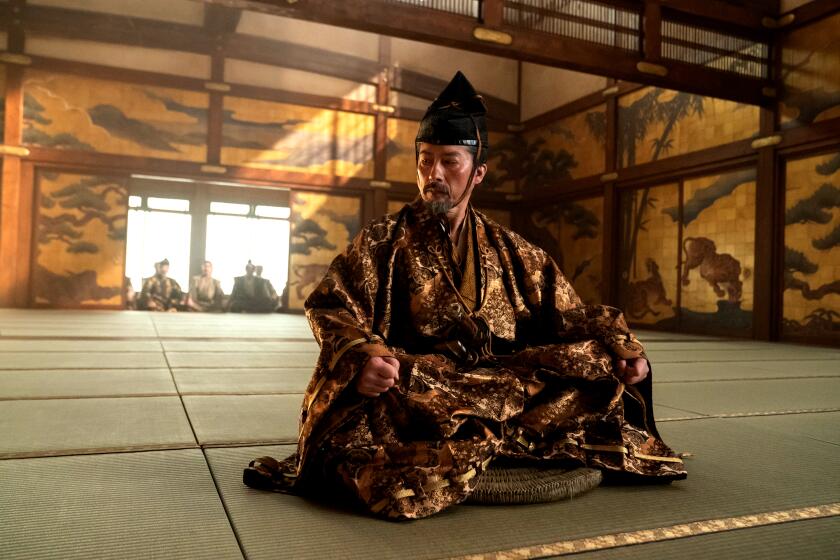TELEVISION : Who’s Minding the Mind? : With ‘The Human Quest: Science and the New Enlightenment,’ KCET’s Roger Bingham is going after the best answers we have so far about life
The white Buddha figure sits atop the black television set, and, for a moment, the Buddha and TV appear to be silly living room partners. In most households, that is what they would always be--a little domestic joke. But in Roger Bingham’s household, they take on a new meaning. Under this roof, the pair look like a union of old and new ways of enlightenment.
Bingham’s house, nestled in the hills here south of downtown, has a habit of making the mind work overtime. That’s appropriate, considering that the subject now occupying Bingham--one of television’s most successful science journalists--is the mind itself. And if “The Human Quest: Science and the New Enlightenment,” his four-part series now in post-production at public station KCET in Los Angeles, comes close to its ambitions, it might set off ideas that make Buddha and the TV set look puny.
“We want to make sure that this series moves in such a way that it mimics the way the brain works,” Bingham says. “I want the viewer to have a bubbling, bouncing brain while watching this.”
The series, to air on PBS nationally sometime between this fall and the following spring, has endured the inevitable gantlet of revisions, rewrites and reconsiderations. Bingham, though, proudly displays his original proposal, written in 1988, its core themes remaining basically intact. One of its key statements is a clue to Bingham’s twin passions, and why he rejects the characterization of television as a vast wasteland: “TV can be a user-friendly electronic interface between the lab and the living room.”
But there is something else driving Bingham, a clear mission he speaks of in terms that television doesn’t usually accommodate: “It seems to me that if we’re going to have any hope of transcending the position where our species finds itself now, and to move in a way where our civic evolution catches up with our technological evolution, we must follow the old Delphic oracle imperative: ‘Know thyself.’ And now we’re beginning to have the technology for doing that. If we have any chance of having some control over our destiny, it’s essential to find out why we act the way we do, and what the balance is between our evolutionary heritage and the cultural overlay we deal with every day.”
As anyone knows who has watched his many science programs, all produced by KCET, Science the Bingham Way has its own overlay--and it’s often very funny.
From his brief early ‘80s science pieces for KCET’s “California Journal” to his half-hour and hourlong specials, including “The Time of Our Lives” and “Inside Information,” Bingham has stirred punning and visual frolics into hard science to yield a heady television mixture. “Fat City,” his show on food and the environment, featured the indelible image of Bingham communing with a dairy cow in a way Woody Allen would have admired. In another program, he sat at a table at Le Dome restaurant and considered ordering “a double serotonin on the rocks”--the substance in the brain that inhibits neurons that stimulate the brain.
Stephen Kulczycki, KCET’s senior vice president and station manager, likes to sum up Bingham’s amusing approach as “a blending of Jonathan Miller, James Burke and George Carlin. He’s definitely playful, and he’s going to mess around with your head.”
In fact, one of Bingham’s early proposals to KCET was for a show that would be titled “A Fun Guide to the Brain.” The very first TV program Bingham worked on--”Why in the World?,” with host Joseph Benti--had the subtitle “Why in the World Is Science Like a Soap Opera?”
Bingham knows he has a way with wit, but at the same time, he cringes at the praise he is given for it: “I wish people didn’t have to think that you have to make science fun, because science is enormous fun in itself. I wish everyone would buy and read all of the books on science I read and thus learn about it themselves. But that’s not going to happen, so maybe one way of hooking people is if I can show them on TV that there’s this extraordinary intellectual adventure going on, and that you don’t have to be worried about it.”
With “The Human Quest,” Bingham is on to what he likes to call the Big Questions, and they have little to do with the soaps. If there’s a guiding historical figure behind the series, he can be spotted in another room in the house that Bingham shares with his wife and creative partner, Linda. Lying on a table there is a collection of postcards of the father of the theory of evolution, Charles Darwin, and of his home in Britain.
That place was one of the early destinations on the ambitious international shooting schedule for the $2-million series. Filming began last summer at Monticello, Thomas Jefferson’s Virginia home, and finished this month. In between, Bingham and crew traveled to the Indonesian temple of Borobudur; locales in Bali, England and France, and key hubs of scientific research such as the Salk Institute in La Jolla, Stanford University’s School of Medicine and the Santa Fe Institute in New Mexico, home of science’s newest discipline, called complexity.
Supporting the show’s considerable brain matter is what Bingham and his creative staff promise will be visual magic. In order to suggest, for instance, the theory that there may be a single controlling substance in the brain that makes consciousness possible, a view of a street in Ojai will be filmed as Bingham would see it on a walk. Then we will see Bingham sitting in the Ojai Playhouse movie theater, watching that scene on the big screen. “In essence,” he says, “I play the role of homunculus, the little man in the brain.”
The “Quest” quartet begins with a segment tentatively titled “The Nature of Human Nature,” which reports on recent studies of how the mind and brain developed and evolved over time.
“Darwin,” Bingham says, “proposed that our physical being is the result of evolution through natural selection. Unlike others--including Alfred Russel Wallace, who co-discovered the natural selection theory--Darwin included the brain in that process. And since the mind is part of the brain, mind and brain together was a package deal for Darwin.”
Among the other puzzles in mind-brain research is the question of why, if nothing in evolution happens before it is needed, our mind was capable of math skills at a time when the species was living in caves and forests. (UC San Diego philosophy scholar and author Patricia Churchland offers a possible answer: The brain was working hard in the bush and doing countless calculations to survive; now that part of the brain labors in the classroom and laboratories.)
The second segment, “Consciousness,” will look into the still-murky area of consciousness, something Bingham says scientists didn’t even touch 20 years ago--”It was ‘the C-word’ back then.” It is a subject now responsible for an explosion of books, and Bingham has talked with some of the important authors, among them Churchland (“Neurophilosophy”), Daniel Dennett (“Consciousness Explained”) and Francis Crick (“The Astonishing Hypothesis”), the co-discoverer of DNA.
For Bingham, one of the segment’s most compelling questions deals with the so-called binding problem: “How is our mind able to put together the shape with the color with the movement, and form it into an image we can make sense of? A very hot notion at the moment is that there may be an area or areas of the brain that act as a chorus of voices in synchrony, that this area links different brain areas together. It’s all quite speculative.”
(Ever mindful of visual metaphors, Bingham will suggest this with footage of a choir singing.)
“The Social Brain” is what Bingham is calling the third segment, which will, among other things, explore what various cultures have in common, such as facial expressions, tendencies toward aggression and altruism. It will even look at the search among scientists at Atlanta’s Yerkes Regional Primate Center to discover if non-human primates have an innate sense of morality.
Any conversation with Bingham suggests, though, that he is especially excited about the fourth segment. Called “The Way of Science,” it posits that the practice of science is itself a way to enlightenment, a never-ending quest for the ultimate answer to life--”that formula explaining everything that you can stick on a T-shirt,” as he puts it.
“I believe that doing science is a kind of workaday holiness,” Bingham says. “What I mean is that I don’t think it’s fair for religion and mysticism to corner the market on awe. Being able to comprehend nature, as Darwin did, is in a sense like reading the book of creation. The stories science tells have such incredible magnitude and importance that, frankly, make other world views rather pokey and medieval.”
In physics, the quest has often been for the elusive Grand Unification Theory. The big story Bingham is after is complexity--a field so new, so avant-garde, that this usually glib, erudite man hesitates giving a quick definition.
Complexity is the sort of thing Bingham loves--making connections, the synthesizing of ideas. At Complexity U.--the Santa Fe Institute--Caltech physicist Murray Gell-Mann and a network of biologists, anthropologists, economists and ecologists are studying systems through nature, from ancient civilizations to rain forests, to find out why a simple system (such as a single cell) will explode into a complex one (such as multiple cells, the emergence of which set off massive development of life on Earth).
“It’s extraordinarily promising,” Bingham says, “because if the study of complex adaptive systems finds a common pattern through nature--simple to more complex, from grunts to language, from a wind to a hurricane, from barter to a global market economy--it may hit on that big unifying idea science has always desired.”
Francis Crick is facing Roger Bingham, and the camera, operated by crack video men Mitch Wilson and Jack Combs, is running. The publicity-shy Crick rarely goes before a camera for anything. But here at the Salk Institute in La Jolla, where Crick works in the office once occupied by the late Jacob Bronowski, host of PBS’ “The Ascent of Man,” he is happy to put across his ideas on mind science to someone he respects.
It is something Bingham enjoys, as he is aware of his special relationship with the often-remote scientific community.
Bingham belongs to the small band of science reporters who plow through vast amounts of scientific literature and distill the information for the rest of us.
“Scientists really do want to talk with him,” notes Churchland of UC San Diego, “because they respect the fact that he really does his homework. He’s one of the best there is. He has a wonderful tenacity to doggedly pursue a question until he finally figures it out.”
Bingham was born in 1948 in the seaside town of Blackpool in England’s northwest. He was drawn to chemistry as a boy by a charismatic teacher; he jumped a few grades and later read chemistry at University College, London. He did not retire to the lab, however; in the watershed political year of 1968, he was president of the university’s student union. “I was the moderate meditator,” he says, “getting some basic student rights.”
After he helped to plan and organize the first student-owned and -managed housing in Britain, Bingham met writer Ray Hawkey. “He asked me if I would do the science research for a novel he was writing, and I said I’d rather co-author it.”
The novel, “Wild Card,” set in an anarchic Los Angeles of the future, brought both writers to L.A. “on the day that the Symbionese Liberation Army was in the gun battle with the police,” Bingham says.
“It wasn’t too long after that I knew I wanted to live here. Everything was more relaxed than England, and I found American scientists more approachable than British ones.”
After “Wild Card” appeared in 1974, Bingham devoted himself to writing about science. One of his magazine assignments--a profile of Carl Sagan during the making of “Cosmos” at KCET--brought him to the station he has been associated with since 1984. Eventually, after his work with Benti and the first science reports for KCET, Bingham persuaded the station to create a science production unit. With Linda, whom he married in 1984, as creative partner, Bingham turned the unit into his little factory for churning out several hours a year of scientific wit and wisdom.
“The Human Quest” is the ultimate product of the unit. It was axed in 1991, a victim of KCET production cuts.
Few TV journalists have sign-on access to Caltech’s computer network, which Bingham faithfully rings into. It’s another indicator of his ties to the scientific community.
“We science communicators,” Bingham says, “are ex-officio, honorary members of the scientific world. They let us in, talk about their ideas even before they publish, and that means that the ideas on the screen are going to be pretty fresh. And because we talk to specialists, it happens that we bring the specialists together to meet for the first time.”
Asked to name a few books that would give the viewer some background for “The Human Quest,” he revealingly mentions works by those in his small band of reporters--such as Matt Ridley and his daring new work “The Red Queen” and Roger Lewin and his witty primer “Complexity: Life at the Edge of Chaos.” (Among Bingham’s other suggestions, by scientists: Helena Cronin’s “The Ant and the Peacock,” Michael S. Gazzaniga’s “Nature’s Mind,” Nicholas Humphrey’s “A History of the Mind” and Melvin Konner’s “The Tangled Wing.”)
But since Bingham works on the tube, and thus for a much bigger audience than Ridley or Lewin, he feels that much more pressure: “You take on a responsibility--it’s also a great pleasure--of passing on invigorating ideas. You see, especially in science reporting, you can’t make mistakes. You’ve got to be factually accurate. I even had to make sure for a shot we were doing involving Descartes that we had the right meaning and spelling of his famous phrase ‘ cogito ergo sum ,’ “--or “I think, therefore I am.”
Nothing goes unchecked, which makes for a long production schedule. When both Linda and Roger explain how they are able to amass the information for the series (“Read a lot,” they say in unison), it also points out that in television, “there’s a point where you have to stop reading and start shooting,” as series co-writer and co-producer Carl Byker says.
To be sure, Byker--a Writers Guild award-winning writer and producer (the 1988 documentary “Power in the Pacific”)--was hired by KCET last year to help press production forward. “The Human Quest” has been on the KCET slate for a while: The original budgeting stretches back to 1991, and research-generated revisions have only stretched production out further.
Everyone at KCET involved with “The Human Quest” marvels at the largess of thK. Whittier Foundation, which has contributed $1.5 million for the series--an unusually large contribution, according to series executive producer Joyce Campbell. The only other funding, $500,000, came from KCET itself.
That forced such budget-cutting measures as shooting on videotape rather than film and forgoing a trip to India for the segment on consciousness.
“So,” Bingham says as he walks along the shore just south of the Salk Institute, “you get inventive. In Indonesia, we were able to shoot at the Borobudur temple--where we show a vision of nature, like complexity, though unlike science it’s written in stone. In that same corner of the world, we could shoot the ‘Wallace Line,’ where Alfred Wallace had detected a division in species, caused as we know now by plate tectonics.”
Bingham waves off any concerns that his evolutionary-revolutionary themes will upset those viewers who hold to a literal interpretation of biblical creation. “We’ll find that science is expansive, not reductive,” he says, looking out at the setting sun. “If it’s complexity or something else that will come up with answers to the Big Questions, we can’t know. Whether they’ll be answers that we like--we can’t know that either.
“People may not pay attention to the answers when they do come. Remember, Darwin’s ‘Origin of Species’ came out in 1859, and millions of human beings still blow it off.”
The complete guide to home viewing
Get Screen Gab for everything about the TV shows and streaming movies everyone’s talking about.
You may occasionally receive promotional content from the Los Angeles Times.



